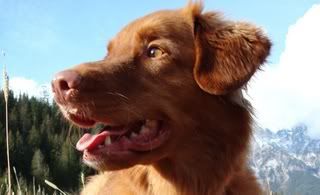Not sure exactly how many this will apply too but if it does then here you go.
Recently The two handlers and there MWD's (Military Working Dogs) that i have deployed with and myself went through MEDEVAC Training. Basicly training for that .5% chance that it could happen. The reason i said it might not apply to some is that i know some LEO departments are very strict on the view that a K9 is just a piece of equipment and would have you drive rather then fly and risk the health of the dog.
Basically the training was worked out to three steps. We had a lot of time and had been talking to the MEDEVAC guys for a bit so we just made one long day of it (that and i was the only one to be hoisted up).
First Part of Training: The first part of training was class work and creating a SOP (Standard Operating Procedure) for both party's. Talk about what needs to happen and what can not happen. Teach the Medics and flight crew about safty around your K9 and they should teach you about Safty around and in the helicopter, they should also go over hand and arm signals considering the noise will be to loud to talk over for the most part. One thing that we had to clear up with the Medic is that if the MWD had to be extracted with a hoist then the handler would have to ride up with the MWD on the hoist and not the Medic, reasoning for this is clear to us but not to them, you need to explain to them exactly why it is. The reasoning for them needing to take the dog up on the hoist is that they train for months on that and they are the only ones qualified to be on it be them selfs, so with us going up with are MWD pretty much went the opposite way of all their training. After explaining why we needed to accompany are MWD's up they completly understood and the plan from that point was the Medic come down and hook the handler and MWD in the hoist and from there call down the helicopter again and hook the cable up to the hoist and once we where lifted and in the helicopter then they would lower the cable back down to the Medic and from there we would be good to go.

 The Second Part of Training:
The Second Part of Training: The second part is familiarization with the K9 and the Helicopter. You should go with your K9 into the Helicopter and Sit down, just hang out in it for a few minutes make sure your dog is calm and relaxed. Do this a few times with the Helicopter off. The next step is to do this with the blades spinning and see how your dog does with the noise and the wind hitting him/her in the face on the way to the helicopter. The main thing is to teach the dog that the helicopter is a safe place. Nothing bad can happen to him/her in there.
Next you need to get the crew familiar with your K9's. Now this is another part where LEO K9 and MWD's differ, we do not socialize are dogs with anyone besides are own handlers. So i think you all have a hand up on us with this one, basicly we had to socialize are dogs so they knew that anyone in the helicopter was a good guy and we also socialized them in the office a bit so they would also get use to the uniform.

 The Third Part of Training:
The Third Part of Training: Now the third part of training is the actual lift and air time with the K9. But first if you are going to use a hoist this is where you practice with the helicopter on the grown getting the hoist on yourself and the K9 hooked up and left the foot off the ground just so you can see what it is like to be "weightless" for that small lift before you do 10, 25, 50 feet.
Once that is all set up you are ready to go out and do the real thing.
Afther this is all said and typed up i do relise that the chances that a LEO K9 would need to use a hoist is even less then what the military would need. But there is always a chance. That chance being if your K9 suffers a injury in the back yard of a suspects house. For some reason you cant get to a vehicles the fastest way to get your dog to the Vet is to Medevac out useing a hoist. Likely? Not really. Possible? Anything is possible. But for the most part if you are going to need a MEDEVAC the helicopter will land and you will load your K9 from the ground rather then the hoist.





One problem with the hoist is this. We have a harness just for this, it is very well made and does its job to standard, the problem is that the dogs are not a fan of getting in and it pretty much puts pressure all over the bod of the dog. The problem is that if the dog is injured then he is not going to be cooperative about being put in the harness. The only thing i can think of is that you are going to have to hurt your dog to help him. Sounds cruel but you do what you need to, to save his life.

Bottom line is if you can take something from this training, i am glad i can help, if there isn't anything you can take from it, well then you have a little insight as to what is going on over on this side.
Michael.West
"Everything flows down leash"
 Previous Topic
Previous Topic Index
Index Next Topic
Next Topic






















 Top
Top
 My hat's off to you.
My hat's off to you.








.jpg)